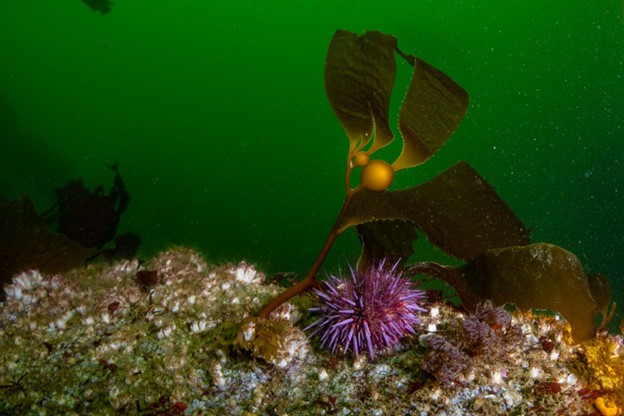An Underwater Snapshot of Kelp Health in Monterey
By Michael Esgro, Senior Biodiversity Program Manager & Tribal Liaison
It was 2013 in Monterey when I learned to scuba dive – one year before a record-breaking marine heatwave arrived off the California coast, bringing with it a “perfect storm” of changing ocean conditions that severely impacted kelp ecosystems across the state. As the heatwave persisted through 2016, much of the kelp off the Monterey Peninsula gradually disappeared. However, the story in Monterey is more nuanced in contrast to the region-wide devastation observed off of California’s north coast where over 95% of bull kelp has been lost in Mendocino and Sonoma Counties – Monterey’s kelp has continued to persist in some places despite harsh conditions.
What does the future hold for kelp in Monterey? I’ve become obsessed with this question, not only because of my role as OPC’s lead on kelp protection and restoration, but also because of my deep personal connection to Monterey’s underwater environment. That’s how I found myself on a dive boat earlier this week, conducting surveys with the California Department of Fish and Wildlife (CDFW) and The Nature Conservancy. Our mission: obtain a snapshot of kelp forest health at a handful of Monterey sites during kelp’s peak growth season.
Our first dive took us to a spot called Otter Cove, just around the corner from Lover’s Point in Pacific Grove. We followed the anchor line down to a reef that was covered in spiky purple urchins, an unmistakable “urchin barren.” After a few minutes of swimming, though, bare rock gave way to kelp so thick I was glad I brought a dive light. There were urchins here too, but they were tucked away in cracks and crevices, feeding passively on drift kelp. Over the course of the day, as we dove our way back towards the Monterey harbor, we observed other strange phenomena that challenged my pre-existing notion of the classic “kelp forest vs. urchin barren” paradigm. For example, at a site off Cannery Row, we observed what appeared to be a kelp forest from the surface. We eagerly descended, but at depth we found large numbers of urchins roaming the reef in between kelp holdfasts, and none of the understory algae that is typically characteristic of these ecosystems. What was causing these unusual patterns?
For our last dive of the day, we had a chance to check out progress on a pilot restoration project at Tanker Reef, where a small army of local volunteer divers have been culling urchins for the past year in the hopes that kelp will return. At this site, volunteers have successfully reduced urchin densities to under two individuals per square meter (the threshold density expected to support the return of kelp), and according to the most recent monitoring surveys, the density of giant kelp has more than quadrupled. These results are encouraging, but additional research will be required to fully evaluate the effectiveness of this particular restoration method, as well as its scalability.
Back on the boat, we discussed what we’d seen over coffee and brownies. Why is Monterey so different from the north coast? One potential answer: the southern sea otter. Around the same time as the marine heat wave, sea star wasting disease resulted in the loss of around 6 billion sunflower sea stars – major urchin predators. Unlike the north coast, Monterey hosts a resident population of sea otters, who also eat urchins and have likely helped to maintain remnant kelp patches. Yet otters only target healthy urchins in kelp forests and tend to avoid urchins in barrens, which are generally starving and not energetically profitable. Hence the persistence of a patchy kelp/urchin mosaic.
Will the balance ultimately shift to kelp or urchin? The story in Monterey is still unfolding, but two things are clear to me: first, we need to keep a close eye on this area, relying on both scuba surveys and advanced remote sensing technologies. And second, we should explore approaches for defending the kelp that remains in Monterey, as part of California’s “learn by doing” approach to building proactive, climate-ready strategies for kelp protection and restoration.
I still love to dive in Monterey. On a very personal level, I’ve been horrified to see the impact that climate change has had on the kelp forests that I consider my second home. But the resiliency of the kelp that I observed this week, the promising results of early restoration work, and the groundswell of interest and engagement from the local community all give me reason for optimism. I hope that someday, Monterey’s iconic underwater forests – the ecosystems that first sparked my passion for scuba – will return and thrive.




